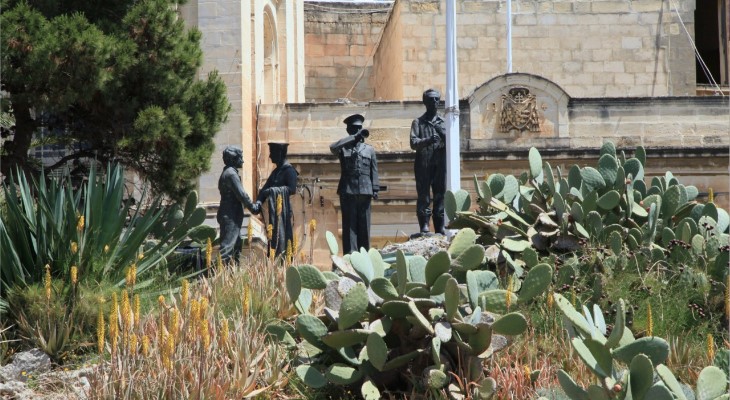There’s no shortage of history on the streets of Malta, but what are those statues and monuments all about?
History is, quite literally, all around you on the Maltese Islands, and we love remembering our country’s past achievements: those special moments that make Malta the place it is today. Monuments, statues, busts and niches adorn public gardens, town squares and street corners, a daily reminder of yesteryear. But who were those people represented in those monuments? What stories lie behind them? Wonder no more. That’s what we’re here for!
Freedom Monument
Dominating the entire square opposite the 17th century church of St Lawrence in Birgu (Vittoriosa), the Freedom Monument is more than just a monument. It is a mound, a veritable man-made hill, an elaborate roundabout commemorating a turning point in Malta’s modern political history.
Designed by prolific local sculptor Antonio Agius, it commemorates the end of an era, when the British government closed down its military base in Malta, on 31 March 1979. Malta had already been granted independence from the British in 1964, and became a republic within the Commonwealth in 1974.
The then prime minister Dom Mintoff had very specific instructions for the sculptor, and was involved every step of the way in all the details concerning the design, from the positioning of the hands of the statues, to the sheen of the letters and the rise of the steps up the mound. Every element was symbolic of this critical moment in time.
The mound was constructed of large stones brought in from Dingli Cliffs, and planted with different types of cactus and other trees, bringing the countryside into urban Birgu. Standing on top of the mound are four full-size allegorical figures representing a British sailor bidding farewell with a last handshake to a Maltese worker, another Maltese worker hoisting the Maltese flag and a bugler. These roles were played out in the actual ceremony on the handover day on 31 March 1979, the first Freedom Day, by leading radio operator David Gilchrist of HMS London, Alfred Xuereb of Bormla (Cospicua), Carmel Boxall of Birgu (Vittoriosa) and PC Richard Cauchi of Hamrun.

Frank Vincentz - Wikimedia Commons
Along the passage leading up to the statues on the mound are bronze phrases and words in Maltese, produced by workers from the nearby dockyard, referring to the workers’ struggle for freedom. Initially, these words were highly polished, but Mr Mintoff changed his mind afterwards and ordered for the letters to be treated with acid to turn them green. He even insisted that the steps up the mound should not be so comfortable, arguing that “nobody laid easy steps for the Maltese in their acquisition of freedom”. The sculptor obeyed and added sand to the steps.
Freedom day is still celebrated every year as a national holiday, with a ceremony at the monument and another at the War Memorial in Floriana. In the afternoon, a highly competitive regatta is held in Grand Harbour.